HL-L8250CDN
FAQs & Troubleshooting |
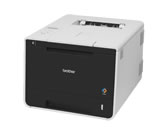
HL-L8250CDN
Date: 20/12/2018 ID: faq00000080_031
What is the recommended paper?
- DO NOT load different types of paper in the paper tray at the same time because it may cause paper jams or misfeeds.
- For correct printing, you must choose the same paper size in your software application as the paper in the tray.
- Avoid touching the printed surface of the paper immediately after printing.
- Before you buy a lot of paper, test a small quantity to make sure that the paper is appropriate for the machine.
- Use labels that are designed for use in laser machines.
Recommended paper and print media
| Europe | USA/ Canada/ Latin America | |
| Plain paper | Xerox Premier TCF 80 g/m2 Xerox Business 80 g/m2 |
Xerox 4200 20 lb Hammermill Laser Print 24 lb (90 g/m2) |
| Recycled paper | Xerox Recycled Supreme 80 g/m2 | (No specific brand recommended) |
| Labels | Avery laser label L7163 | Avery laser labels white #5160 |
| Envelope | Antalis River series (DL) | (No specific brand recommended) |
| Glossy paper | Xerox Corotech+ Gloss Coated 120/m2 |
NewPage Futura Laser Gloss Xerox Digital Color Elite Gloss |
Paper capacity of the paper trays and Media type
| Paper Size | Paper type | No. of sheets | |
| Standard paper tray (Tray 1) |
A4, Letter, Legal *1, B5 (JIS), Executive, A5, A5 (Long Edge), A6, Folio *1, *2 |
Plain paper, Thin paper, Recycled paper |
up to 250 sheets [80 g/m2 (20 lb)] |
| Multi-purpose tray (MP Tray) |
Width: 76.2 to 215.9 mm (3.0 to 8.5 in.) Length: 127 to 355.6 mm (5 to 14 in.) |
Plain paper, Thin paper, Thick paper, Thicker paper, Bond paper, Recycled paper, Bond paper, Labels, Envelopes, Env. Thin, Env. Thick Glossy paper *3 |
up to 50 sheets [80 g/m2 (20 lb)] 3 Envelopes 1 Glossy paper |
| Optional lower tray (Tray 2) |
A4, Letter, Legal *1, B5 (JIS), Executive, A5, Folio *1, *2 |
Plain paper, Thin paper, Recycled paper |
up to 500 sheets [80 g/m2 (20 lb)] |
*1: Legal or Folio size paper are not available in some countries.
*2: Folio size is 215.9 x 330.2 mm (8.5 x 13 in.).
*3: Load only one sheet of Glossy in the MP tray.
*4: Tray2 is standard on HL-L9200CDWT.
Recommended paper specifications
The following paper specifications are appropriate for this machine:
| Basis weight | 75-90 g/m2 (20-24 lb) |
| Thickness | 80-110 μm |
| Roughness | Higher than 20 sec. |
| Stiffness | 90-150 cm3/100 |
| Grain direction | Long grain |
| Volume resistivity | 10e9-10e11 ohm |
| Surface resistivity | 10e9-10e12 ohm-cm |
| Filler | CaCO3 (Neutral) |
| Ash content | Below 23 wt% |
| Brightness | Higher than 80% |
| Opacity | Higher than 85% |
- Use plain paper that is appropriate for laser machines to make copies.
- Use paper that is 75 to 90 g/m2 (20 to 24 lb)
- Use long grain paper with a neutral Ph value, and a moisture content of approx. 5%.
- This machine can use recycled paper that meets DIN 19309 specifications.
Handling and using special paper
The machine is designed to work well with most types of xerographic and bond paper. However, some paper variables may have an effect on print quality or handling reliability. Always test samples of paper before purchasing to ensure desirable performance. Store paper in its original packaging and keep it sealed. Keep the paper flat and away from moisture, direct sunlight and heat.
- DO NOT use inkjet paper because it may cause a paper jam or damage your machine.
- Preprinted paper must use ink that can withstand the temperature of the machine's fusing process 200 degrees centigrade (392 degrees Fahrenheit).
-
If you use bond paper, paper having a rough surface or paper that is wrinkled or creased, the paper may
exhibit degraded performance.
Some types of paper may not perform well or may cause damage to your machine.
DO NOT use paper:
- that is highly textured
- that is extremely smooth or shiny
-
that is curled or warped
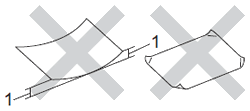
1 A curl of 2 mm (0.08in.) or greater may cause jams occur. - that is coated or has a chemical finish
- that is damaged, creased or folded
- that exceeds the recommended weight specification in this guide
- with tabs and staples
- with letterheads using low temperature dyes or thermography
- that is multipart or carbonless
- that is designed for inkjet printing
If you use any of the types of paper listed above, they may damage your machine. This damage is not covered under any Brother warranty or service agreement.
Envelopes
Most envelopes can be used with your machine. However, some envelopes may have feed and print-quality problems because of the way they have been made. Envelopes should have edges with straight, well-creased folds. Envelopes should lie flat and not be of baggy or flimsy construction. We recommend printing a test envelope to make sure the print results are what you want.
- that are damaged, curled, wrinkled or an unusual shape
- that are extremely shiny or textured
- with clasps, staples, snaps or tie strings
- with self-adhesive closures
- that are of a baggy construction
- that are not sharply creased
- that are embossed (have raised writing on them)
- that were previously printed by a laser or LED machine
- that were pre-printed on the inside
- that cannot be arranged neatly when stacked
- that are made of paper that weighs more than the paper weight specifications for the machine
- with edges that are not straight or consistently square
- with windows, holes cut-outs or perforations
-
with glue on the surface as shown in the figure below
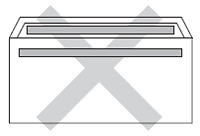
-
with double flaps as shown in the figure below
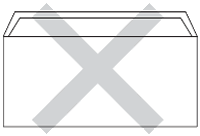
- with sealing flaps that are not folded down when purchased
-
with each side folded as shown in the figure below
If you use any of the types of envelopes listed above, they may damage your machine.This damage may not be covered under any Brother warranty or service agreement.
Labels
Most labels can be used with your machine. Labels should have an adhesive that is acrylic-based since this material is more stable at the high temperatures in the fuser unit. Adhesives should not come in contact with any part of the machine, because the label stock may stick to the drum unit or rollers and cause jams and print quality problems. No adhesive should be exposed between the labels. Labels should be arranged so that they cover the entire length and width of the sheet. Using labels with spaces may result in labels peeling off and causing serious jams or print problems.
all labels used in this machine must be able to withstand a temperature of 200 degrees centigrade (392 degrees Fahrenheit) for a period of 0.1 seconds.
Labels can only be fed through the multi-purpose tray.
-
DO NOT use labels that are damaged, curled, wrinkled or an unusual shape.
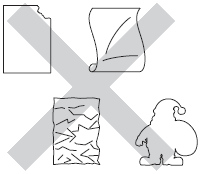
- DO NOT feed partially used label sheets or labels with the carrier sheet exposed because your machine will be damaged.
- DO NOT reuse or insert labels that have been used previously or are missing a few labels on the sheet.
- Label sheets should not exceed the paper weight specifications described in this User's Guide. Labels exceeding this specification may not feed or print correctly and may cause damage to your machine.
Related FAQs
HL-L8250CDN, HL-L9200CDW, MFC-L8850CDW, MFC-L9550CDW
If you need further assistance, please contact Brother customer service:
Content Feedback
Please note this form is used for feedback only.